Related Research Articles

The United States Lighthouse Service, also known as the Bureau of Lighthouses, was the agency of the United States Government and the general lighthouse authority for the United States from the time of its creation in 1910 as the successor of the United States Lighthouse Board until 1939 when it was merged into the United States Coast Guard. It was responsible for the upkeep and maintenance of all lighthouses and lightvessels in the United States.

Barnegat Lighthouse, or Barnegat Light, is a historic lighthouse located in Barnegat Lighthouse State Park on the northern tip of Long Beach Island, in the borough of Barnegat Light, Ocean County, New Jersey, United States, on the south side of Barnegat Inlet.

The United States Lighthouse Board was the second agency of the U.S. federal government, under the Department of Treasury, responsible for the construction and maintenance of all lighthouses and navigation aids in the United States, between 1852 and 1910. The new agency was created following complaints of the shipping industry of the previous administration of lighthouses under the Treasury's Lighthouse Establishment, which had had jurisdiction since 1791, and since 1820, been under the control of Stephen Pleasonton.
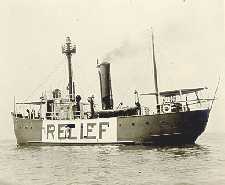
The United States lightship Huron (LV-103) is a lightvessel that was launched in 1920. She is now a museum ship moored in Pine Grove Park, Port Huron, St. Clair County, Michigan.
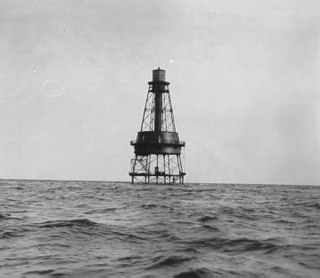
Carysfort Reef Light is located on Carysfort Reef east of Key Largo, Florida. The lighthouse has an iron-pile foundation with a platform, and a skeletal, octagonal, pyramidal tower, which is painted red. The light was 100 feet (30 m) above the water. It was the oldest functioning lighthouse of its type in the United States until it was decommissioned in 2015, having been completed in 1852. The light last installed was a xenon flashtube beacon. It was added to the National Register of Historic Places in 1984.
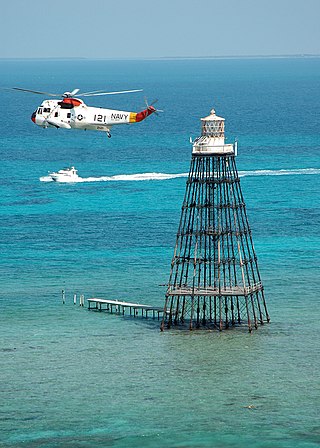
Sand Key Light is a lighthouse 6 nautical miles southwest of Key West, Florida, between Sand Key Channel and Rock Key Channel, two of the channels into Key West, on a reef intermittently covered by sand. At times the key has been substantial enough to have trees, and in 1900 nine to twelve thousand terns nested on the island. At other times the island has been washed away completely. The light marks the southernmost point of the Hawk Channel passage along the Florida Keys.

The St. Johns River Light is a decommissioned lighthouse in Jacksonville, Florida, U.S., which stands near the mouth of the St. Johns River. It is located on the grounds of Naval Station Mayport in the Mayport area. Constructed in 1858, it was decommissioned in 1929 and replaced with a lightship. It is sometimes known as the "Old St. Johns River Light" to distinguish it from the modern St. Johns Light, built in 1954.

A lighthouse keeper or lightkeeper is a person responsible for tending and caring for a lighthouse, particularly the light and lens in the days when oil lamps and clockwork mechanisms were used. Lighthouse keepers were sometimes referred to as "wickies" because of their job trimming the wicks.

Cape Mendocino Light was a navigation light at Cape Mendocino, California. The former lighthouse was relocated to Shelter Cove near Point Delgada, California in 1998, and the historic Fresnel lens to Ferndale, California, in 1948. An automated beacon operated for a number of years but was removed in May 2013.

Wolf Trap Light is a caisson lighthouse in the Virginia portion of the Chesapeake Bay, about seven and a half miles northeast of New Point Comfort Light. It is listed on the National Register of Historic Places.
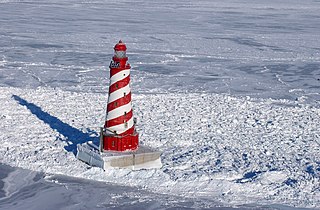
The White Shoal Light is a lighthouse located 20 miles (32 km) west of the Mackinac Bridge in Lake Michigan. It is an active aid to navigation. It is also the tallest lighthouse on the Great Lakes.

Poe Reef is a lighthouse located at the east end of South Channel between Bois Blanc Island and the mainland of the Lower Peninsula, about 6 miles (9.7 km) east of Cheboygan, Michigan.

Warwick Light, also known as Warwick Lighthouse, is an historic lighthouse in Warwick, Rhode Island, United States.
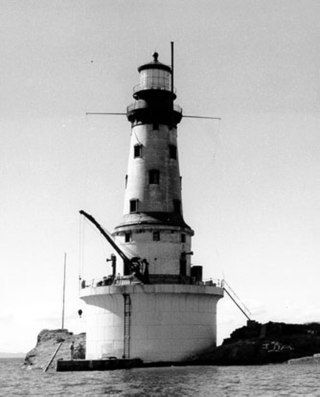
The Rock of Ages Light is a U.S. Coast Guard lighthouse on a small rock outcropping approximately 2.25 miles (3.62 km) west of Washington Island and 3.5 miles (5.6 km) west of Isle Royale, in Eagle Harbor Township, Keweenaw County, Michigan. It is an active aid to navigation.
A traveling library is a collection of books lent for stated periods by a central library to a branch library, club, or other organization or, in some instances, to an individual. The chief characteristics from which it derives its name are its temporary location in the place to which the collections of books is sent and the implication that any traveling library will or may be changed for another collection of books. A bookmobile is an example.

The New York Free Circulating Library (NYFCL) was founded in 1879 and incorporated in 1880. Its aim was to supply free reading material and reading rooms to the people of New York City. Over its lifetime, it expanded from a single location to eleven locations and an additional traveling department. It was notable for the large part women played in its administration and staffing. In 1901, the system became part of the New York Public Library.

The Point Gammon Light was a lighthouse that stood on its eponymous point at the south end of Great Island in West Yarmouth, Massachusetts, on the east side of Lewis Bay and the entrance to Hyannis Harbor. Long inactive, it was converted into an ornithological observation tower in the late 19th century.
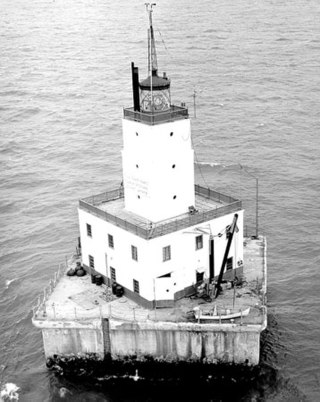
The North Manitou Shoal Light, also known as the North Manitou Light or, locally, The Crib, is a lighthouse located in Lake Michigan, southeast of North Manitou Island in Leland Township, Michigan. When it was automated in 1980, it was the last manned offshore light in the Great Lakes. It was listed on the National Register of Historic Places in 2005.
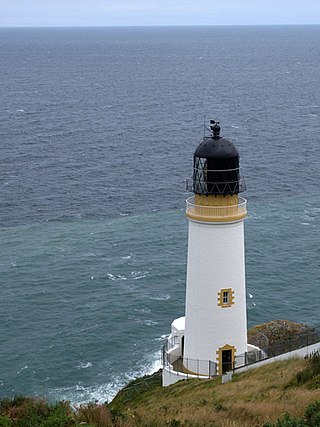
Maughold Head Lighthouse is an active 20th century lighthouse, located on the headland of the same name at the southern end of Ramsey Bay on the eastern coast of the Isle of Man. Completed in 1914, it was designed by David A and Charles Stevenson.
References
- ↑ Waterway, William (2014). "The Lighthouse Libraries: Setting the Stage for America's Library System". Gay Head Lighthouse: the first light on Martha's Vineyard. Charleston, South Carolina: The History Press. Chapter 11. ISBN 978-1-62619-406-9.
- 1 2 3 4 Johnson, Arnold B (Jan 29, 1885). "Lighthouse Libraries". The Christian Union. 31 (5). New York: The Christian Union Company: 9.
- ↑ The National Cyclopædia of American Biography. Vol. 16. New York: James T. White & Company. 1937. pp. 180–1.
- 1 2 3 4 Holland, F. Ross (1972). America's lighthouses: their illustrated history since 1716. Brattleboro, Vt: S. Greene Press. p. 50. ISBN 978-0-8289-0148-2.
- 1 2 3 Johnson, Arnold Burges (1889). The modern light-house service. Washington: Government Printing Office. p. 104.
- 1 2 Avery, Myrtilla (1901). "Summary of New York and other traveling library systems". Traveling Libraries. Home Education Department. Bulletin 40. Albany: University of the State of New York. p. 115.
- 1 2 3 4 5 Yarborough, Margaretta J. (1992). "Library Service to the Strands: North Carolina's Lighthouse Libraries". North Carolina Libraries. 50 (1): 27–30. doi: 10.3776/ncl.v50i1.2511 . ISSN 0029-2540.
- ↑ Weiss, George (1926). The lighthouse service: its history, activities, and organization. Baltimore, Maryland: The Johns Hopkins Press. p. 80.